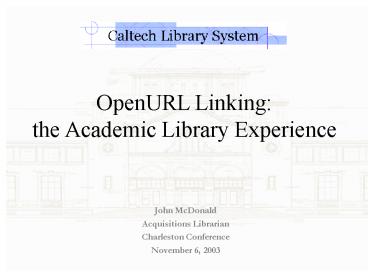OpenURL Linking: the Academic Library Experience - PowerPoint PPT Presentation
1 / 9
Title:
OpenURL Linking: the Academic Library Experience
Description:
... report, then a love letter, more love letters, then more subscription requests... Our users love it They have difficulty remembering the 'dark days' ... – PowerPoint PPT presentation
Number of Views:76
Avg rating:3.0/5.0
Title: OpenURL Linking: the Academic Library Experience
1
OpenURL Linking the Academic Library Experience
- John McDonald
- Acquisitions Librarian
- Charleston Conference
- November 6, 2003
2
SFX at Caltech
- Why did Caltech choose SFX?
- What is enabled at Caltech?
- How does it work?
- What were the issues surrounding release of SFX
to the campus? - How do our users like it?
- How hard is it to maintain?
- Other frequently asked questions...
3
Why SFX?
Reference Linking Allows researchers to
seamlessly transition from one information
resource to another, easily linking them to
full-text articles, to follow citations, or to
find more information about the author, resource,
or topic. Context Sensitivity Links that are
presented to the user are determined by the
journal and are specific to an institution's
collections. Local Control Library staff
determine the best choices to present to the
user.
4
SFX'd Resources at Caltech
- SFX Sources
- Now All major bibliographic databases
- Not yet OPAC (Innopac)
- SFX Targets
- Fulltext Journal Publishers All major
publishers! Over 80 publishers and a total of
4105 journals (over 96 of our serial collection)
- Other Bibliographic Resources ILLIAD Document
Delivery System, Local OPAC (Innovative),
Feedback Form, Web of Science, PubMed
5
SFX in ACTION
- Here are a few examples of how SFX works, in real
life....Let's start in the Web of Science, do
some searching, get some articles, see what our
other options are...
6
SFX in ACTION
- Heres another exampleWhat goes well with beer?
Lets search Grilling and Beef.
7
SFX Release Issues
- When to release? We wanted to wait to release
until after we had a "critical mass" of Sources
and Targets. This would make the system seem
like an overwhelming improvement and not
resource-specific. CLS thought it was essential
to have Web of Science OVID as Sources and it
was important, though not essential, to have
Innopac as a Source.
User Education Issues Caltech decided to keep
the "branded" SFX button and continue to call the
resource SFX. The Library User Education Team
was consulted about education issues and their
conclusion was to incorporate SFX instruction
into already existing library instruction
sessions. An Executive Summary was produced and
paired with an SFX FAQ to inform and instruct our
community.
Response Immediate! Betsy enabled at 901 AM on
Monday and we had an email by the next morning
a faculty request for a new subscription! Then a
bug report, then a love letter, more love
letters, then more subscription requests...But
mostly people just started USING it and have
NEVER LOOKED BACK...
8
Working with SFX The FAQs of Life
- How hard is it to get the system up and running?
- What do you still do after the system is
functional? - How long does it take and how many staff are
involved? - How hard is it and what skills does it take?
- How do users like it and what do the use
statistics look like?
Not very hard at all. Organizing your own
collections data is the most time consuming
aspect of the setup.
Regular monthly updates, weekly knowledgebase
(content data) updates, and daily
troubleshooting. Frequent updates due to your
changing library subscriptions.
At Caltech, we only have two staff members who
are regularly involved in updating the database.
Its not brain surgery most librarians and
programmers can get it up, running, and regularly
maintained.
Our users love it They have difficulty
remembering the dark days of finding fulltext
by their wits and wiles.
9
How do your library users feel?
Your patron now

